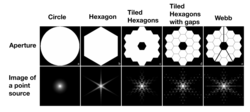Diffraction
Diffraction is a physics concept which occurs when waves bend around small obstacles, or spread out after they pass through small openings. Diffraction occurs with all waves, including sound waves, water waves, and electromagnetic waves such as light that the eye can see. Diffraction also occurs with as electrons.
Causes of diffraction
Diffraction is caused by one wave of light being shifted by a diffracting object. This shift will cause the wave to have interference with itself. Interference can be either constructive or destructive. When interference is constructive, the intensity of the wave will increase. When interference is destructive, the intensity will decrease, sometimes to a point where it is completely destroyed. These patterns of interference rely on the size of the diffracting object and the size of the wave. The strongest examples of diffraction occur in waves where the wavelength is similar to the size of the object causing diffraction.
Uses of diffraction
Diffraction can be used to separate different wavelengths of light using a diffraction grating. A diffraction grating can be a series of closely-spaced slits or a mirror with a series of small grooves. Diffraction gratings work because different wavelengths of light will constructively interfere at different angles. Diffraction gratings are used in many analytical chemistry tools, such as a spectrometer.
Diffraction can also be used to look at molecules using X-ray crystallography. In X-ray crystallography, X-rays are aimed on a crystal. The crystal diffracts the X-ray and makes a diffraction pattern. This pattern is unique to the type of crystal and can be used to identify the molecule that makes the crystal. Diffraction also occurs in a bending movement where the wave becomes more spread out
Diffraction Media
A diffraction pattern of a red laser beam projected onto a plate after passing through a small circular aperture in another plate
Infinitely many points (three shown) along length d project phase contributions from the wavefront, producing a continuously varying intensity \theta on the registering plate
Single-slit diffraction in a circular ripple tank
The bright spot (Arago spot) seen in the center of the shadow of a circular obstacle is due to diffraction
A demonstration of the interference and diffraction pattern obtained from a diffraction grating. For more information on using this video for your projects, check out cosmicnoon.com/illustrations-hq/
References
Skoog, D.A.; Holler, F.J.; Crouch, S.R. Principles of Instrumental Analysis. (Brooks/Cole, California). ISBN 0-495-01201-7 http://commons.wikimedia.org/wiki/File:Young_Diffraction.png










